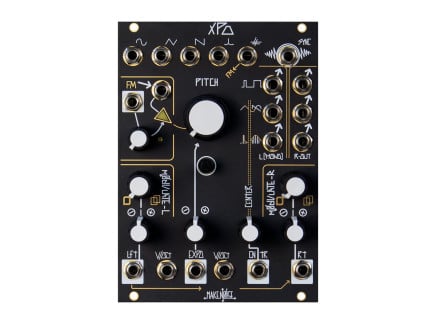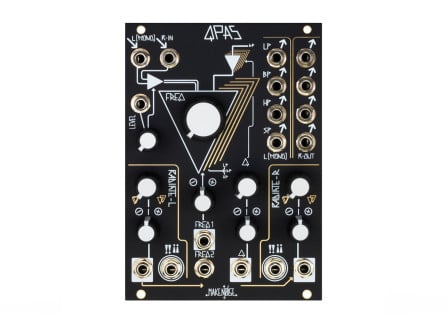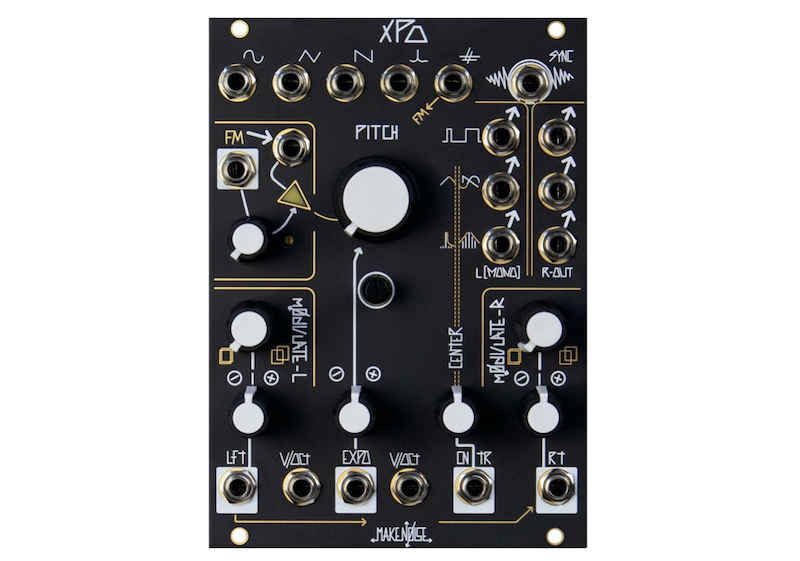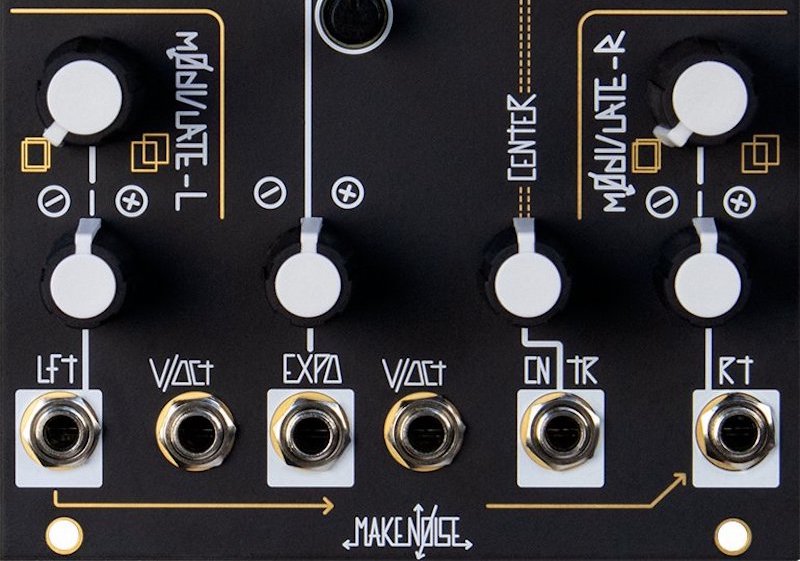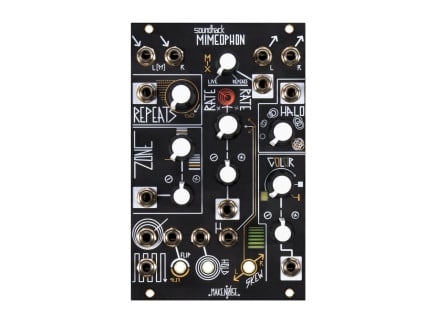Hot dang folks, Make Noise has announced a new oscillator. Tony Rolando and Rodent came by our shop to show us the newest thing they've been working on, and we're pleased to say that it's pretty amazing: it's an all-analog stereo oscillator called XPO. It borrows many ideas and features from the familiar DPO and STO, and as you might expect, it's full of quirks, charm, and downright clever approaches to synthesis, waveshaping, spatialization, and much more. It's Make Noise's first release since 2021's Strega, and their first Eurorack module since 2019's Mimeophon...and we're psyched.
In short, XPO is a single analog oscillator with multiple pairs of waveshapers, intended to make it simple to create stereophonic motion through the use of waveshaping techniques rather than through conventional panning alone. You can think of it as being an oscillator complement to Make Noise's QPAS stereo filter, and no doubt, understanding QPAS's parameterization will only make it easier for you to wrap your head around XPO. However, XPO stands on its own, and will no doubt be useful to any modular synthesizer player interested in complex timbres and unique means of spatialization. I'd wager that if you're reading this, you'll probably find it quite interesting.
Scope out the video above (skip to around 39 minutes in) to see and hear XPO explained by its creator and associates, and read on for some more thoughts about how XPO fits into the Make Noise family, and what makes it particularly special. I regrettably wasn't able to spend time with the module at the event, but I've already pored through Tony's presentation a few times, and have a few ideas I know that I'm excited to explore with XPO...so that said, let's dive in.
Stereo is the New Mono
Thinking back only a few years to 2015 or so, there seemed to be a strong sense among the Eurorack modular synth world that we were in need of more options for stereo mixing and processing. There weren't many stereo Eurorack effects, filters, VCAs, or sound sources...and as such, to create a sense of motion in the stereo field, you often had to resort to use of panners or you had to double up on certain modules—using two VCAs to gate a stereo sound source, for instance.
Of course, the "doubling up" approach wasn't necessarily attractive to many folks—in some cases, it might feel like a waste of a module, or at least, it might feel like there could be a more seamless way of achieving your musical vision. I feel that there was also a certain sense (perhaps only among the nerdiest of us) that bread-and-butter panning processes weren't quite interesting enough, and that there might be more clever ways to achieve spatialization effects. But hey—what's wrong with panning, you might ask?
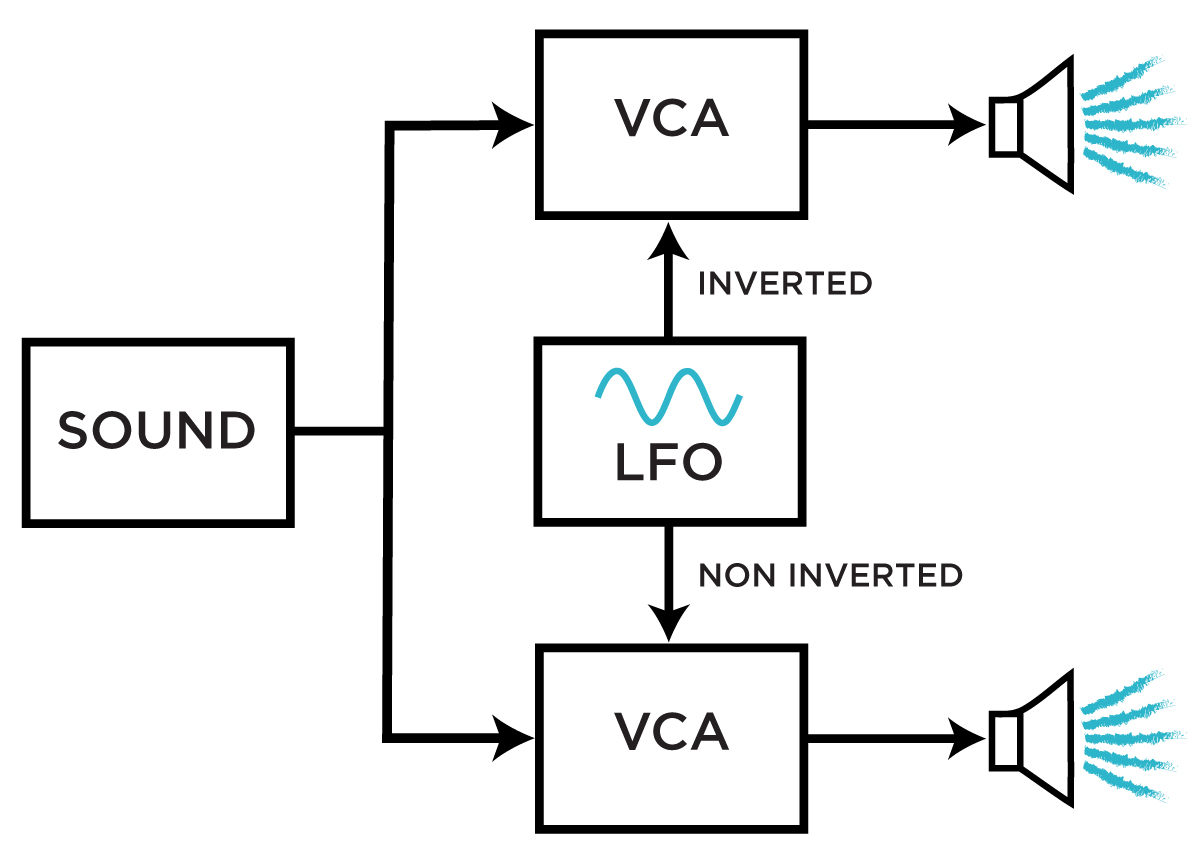 Simple patch diagram of a typical VCA-based panning scheme
Simple patch diagram of a typical VCA-based panning scheme
There's nothing wrong with panning, per se—but in some cases, automated/modulated panning can feel somewhat unnatural, like you're artificially processing a sound in a way that is at odds with its own character or sonic identity. Usually, panning involves sending a single mono sound source into two VCAs (one hard-panned left, and the other hard-panned right), and then using a single modulation source to inversely affect the loudness of each VCA—making it such that one gets louder as the other gets quieter. And while this works very well for creating a sense of placement between two speakers, it doesn't necessarily account for all of the ways that sounds change in real life as they move toward and away from us. In real life, sounds become brighter or darker as they approach us; moreover, even a single sound arrives at each of our ears at different times, with slightly different levels of coloration. So simple automated panning, a process which only affects a sound's proportional loudness between each of our ears can sound...a bit fake, in a way. Sometimes, that's perfectly fine! But sometimes, being able to couple that type of movement with some sort of timbral movement can be much more satisfying and visceral. In the best situations, that can lead to a more engaging playing experience.
In some ways, creative manipulation of the stereo field seems to be at the heart of most of Make Noise's most recent Eurorack modules. The introduction of the Erbe Verb and Morphagene seemed to create the need for more stereo mixing/processing within their own ecosystem, and in the ensuing years, they obliged: their four most recent Eurorack modules (QPAS, X-PAN, XOH, and Mimeophon) all offer either utility specifically aimed at stereo spatialization or some new creative way of creating stereophonic motion.
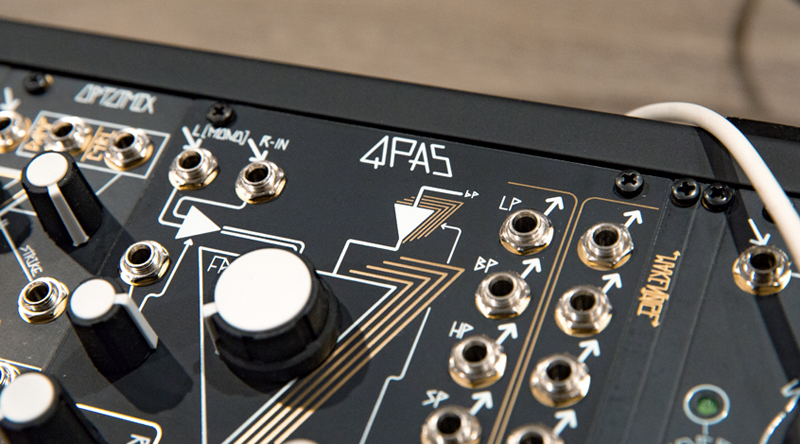
Among these, QPAS perhaps best exemplifies what I perceive as a particularly interesting approach to stereo field manipulation. I won't blab on about this too much here, but the basic idea is this: if you have a nearly-identical sound hard-panned to each ear, and have the ability to subject each copy to similar-but-somewhat-independent forms of processing, you can create some really bizarre, wonderful types of stereophonic motion.
QPAS achieves this by using multi-mode filters, two for each ear. Each "side" of the stereo image has a dedicated "Radiate" parameter, which controls the difference in cutoff frequency between the two filters on each side of the stereo field (with the single large cutoff frequency control affecting all filters equally). In practice, this means that you can do all sorts of things to create bizarre stereo motion, turning even the simplest of incoming sounds (be they mono or stereo) into a swirling soup of stereo swoops.
QPAS has become a staple part of many Eurorack systems, and a core part of Make Noise's own Tape & Microsound Music Machine system, offering filtering and panning for their Morphagene, Mimeophon, and other modules. Of course, QPAS is also great with Make Noise's DPO (Dual Prismatic Oscillator), but using two oscillators for stereo tricks can be somewhat tricky. As such, I've wondered what a Make Noise "stereo oscillator" might be like...and now we know. Let's take a look at XPO.
Make Noise XPO Stereo Oscillator Overview
XPO (Xtereo Prismatic Oscillator? Xtreme Prismatic Oscillator?) is an analog oscillator designed specifically for stereo trickery. Now, you might immediately think that that means that XPO contains multiple oscillators, but that's not really true—rather than dedicating an independent internal oscillator to each side of the stereo field, it instead uses a single oscillator core with multiple sets of waveshapers, allowing you to use classic analog waveshaping techniques like wavefolding, PWM, and more in order to create a sense of stereo motion. This is very much in line with the type of spatialization techniques I was describing above...but before getting into that, let's take a closer look at some of XPO's main features.
Being a single analog oscillator, XPO does offer all the classic features you might expect. It has a pair of frequency control knobs (one coarse tune, one fine tune). It offers a number of ways of controlling its frequency: two 1V/oct inputs (great for transposing sequences or just controlling pitch from multiple sources), an exponential CV input with a dedicated attenuverter, and a dynamic linear FM input, with CV control over the FM index/depth. The oscillator's own sub output is normalled into the FM input, great for creating brutal snarls and growls. It also features a sync input, which employs a quirky not-quite-hard-sync, not-quite-soft-sync approach for creating unique sonic character. Based on what we've heard so far, the sync circuit alone seems quite unique and interesting.
Along the top of the module, it also has direct outputs for a number of classic wave shapes: sine, triangle, saw, spike, and a suboscillator output. By all accounts, even just using XPO as a standard mono oscillator sounds great and is well worth it...the rest, though, is where things get particularly interesting.
The right side of the module features three pairs of outputs: two for Pulse Width Modulation (PWM), two Stereo Vari-Timbre outputs, and two Wavefolded outputs. On the left and right sides of the module, you'll notice two knobs labeled Modulate-L and Modulate-R: these affect the waveshaping on the left output and right output of each pair, respectively. So, that is to say, when you turn the Modulate-L knob, it affects the Left output of the PWM, Vari-Timbre, and Wavefolded pairs simultaneously, while the Modulate-R knob affects the Right output of each of these pairs. Additionally, the Center parameter affects both sides of the Vari-Timbre and Wavefolded outputs in different ways. To better understand, let's go through each pair in order.
The PWM outputs produce straightforward variable-width pulse waves, great for creating stereo swarms of buzzing, churning waves—according to Tony, this is where the core idea for XPO began. The Vari-Timbre outputs are a bit different. The Center parameter continuously blends between a sine and saw wave at the left and right Vari-Timbre outputs (inspired by the Buchla 158 and 258). The Modulate controls gradually introduce a triangle wave, create all sorts of buzzing/cutting textures on the way...a circuit adapted from the STO's shape parameter, as the XPO's panel graphics might imply. Lastly, based on Tony's demos, it seems the Wavefolded outputs work much like the DPO's wavefolder: when the Modulate parameters are fully counterclockwise, these outputs are silent, and gradually increase in volume and then introduce folds as Modulate is increased. The Center parameter seems to introduce some buzzier tones, but unless I missed it, this wasn't discussed in depth in Tony's demonstration.
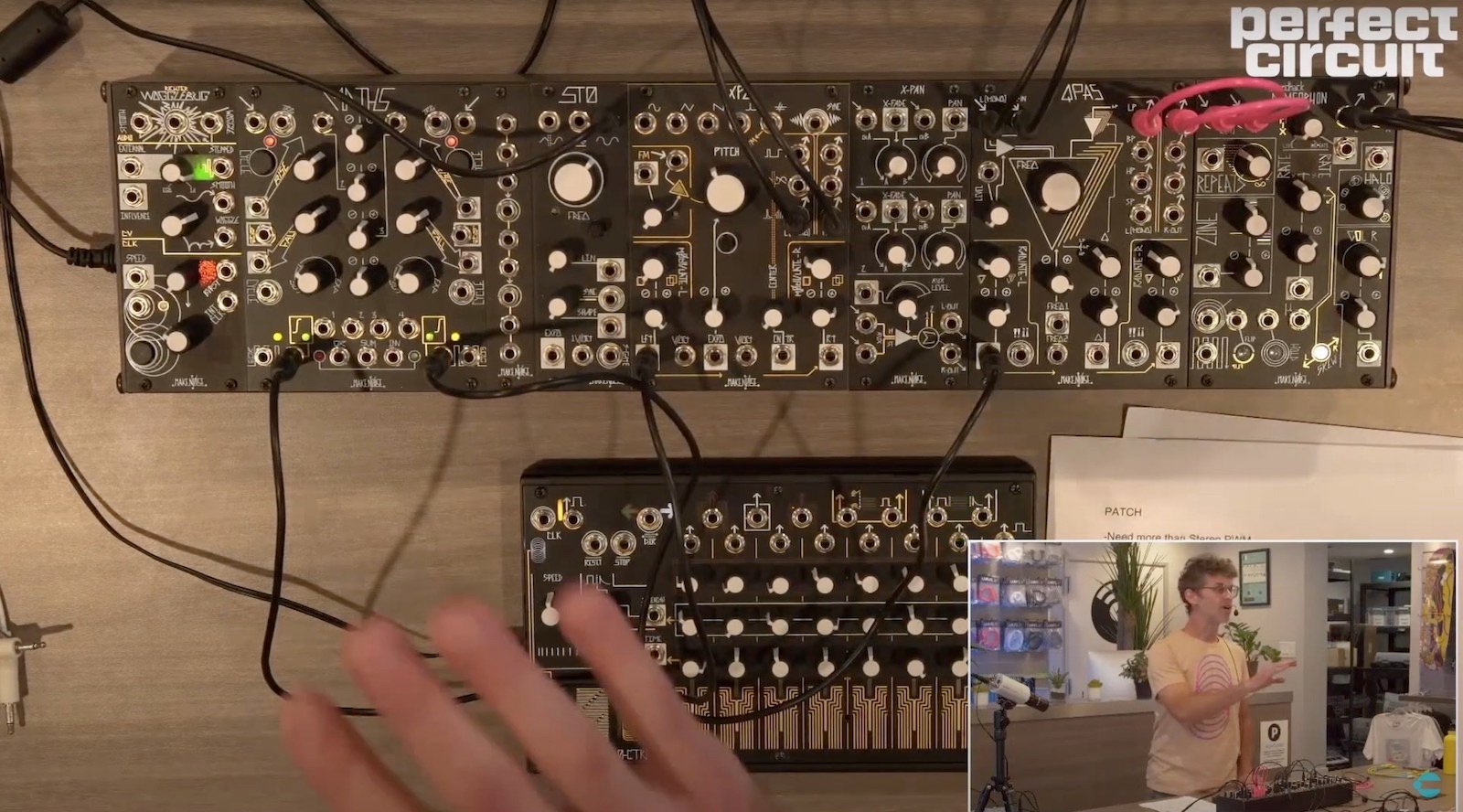
Those familiar with QPAS will notice that the layout for XPO's Modulate parameters is quite similar to QPAS's Radiate parameters. Modulate-L and Modulate-R each have independent CV inputs, each with a dedicated attenuverter. Like on QPAS, these control voltage inputs seem to be normalled together. As such, with some clever tweaking, you can do all sorts of tricks—perhaps most interestingly, you can use one CV to inversely modulate each side of the stereo image by setting your attenuverters appropriately. The Center parameter also features a dedicated CV input, allowing for additional animation independent of the Modulate controls themselves. It's also interesting, as Tony notes in his demo, that the Center parameter doesn't affect all of the stereo outputs, making it possible to do interesting things like audio-rate modulation of Center while still maintaining a stable, clear, pure pitch from the PWM outputs.
It's worth noting that the stereo outputs need not necessarily be used in stereo. In fact, when you patch only from the left output of each pair, you'll get a unique mono version of the stereo waveforms over a single cable—making for some serious, dual-waveshaped oscillator tones for further filtering and processing. There is...a lot to ponder here.
Opening the Stereo Field
How does this sound? Frankly, it sounds huge, buzzy, fizzy, and dizzying (in the best possible way). Even just using a simple LFO or envelope, it should be possible to create churning, swirling stereo motion that always feels full. By independently modulating each side's Modulate control, you could create disjunct, peculiar forms of stereo imaging; and as we saw in the demo, when combining with QPAS or X-PAN, there are whole realms of sound waiting to be discovered.
 Detail of the FM Index level LED, via Make Noise's Instagram page
Detail of the FM Index level LED, via Make Noise's Instagram page
XPO offers too many sonic opportunities to fully grasp without getting my hands on it and really spending some time with it. That said, despite the fact that its functions, layout, and basic uses are fairly clear, it does leave me with a lot of questions. What could you achieve by self-patching it? What does it sound like to cross-modulate the waveshapers? How awesome would it be to pair with a Morphagene for crazy stereo action? What if you had two of them!?
Any module that leaves me asking these sorts of questions is one that I can't help but think is worth careful consideration. In some part, that's probably the result of my own musical sensibilities—but frankly, I also think that this is just a phenomenon common to most or all Make Noise modules. Sure, it's obvious enough how an analog oscillator works, and it's obvious enough how a wavefolder works. But the way that these otherwise simple features combine makes for something fun, something that leaves me excited to explore. I expect that a lot of other folks will feel the same way.

